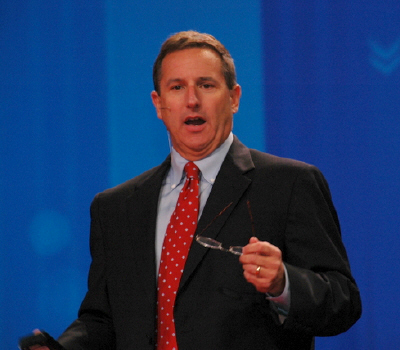HP CEO Mark Hurd offers his formula for fixing IT

Preceded by blasting heavy metal and a new Madonna song "Sorry," with lyrics about being sorry for lying (he didn't choose the music), HP CEO Mark Hurd made his first major appearance in the post-HPGate era. In his OracleWorld keynote address, Hurd started out by saying he hadn't executed a strategy of staying out of the news in the recent past, and got a few laughs.
Unlike the other keynoters, Hurd stood on stage without notes, slides, videos or telepromter and delivered a personable, confident and high energy update on HP's business. He told the crowd that he wants to make HP and easier company to work with. "We don't have a strategy to complexify everything, if that's a word," Hurd said.

"We have a lot of work to do to get better and we are committed to doing that," Hurd said in describing organization changes under his leadership, undoing the Fiorina organization. "We have reduced almost three layers of people, and reduced the number of matrices and simplify the company to get faster and do better," he said.
Hurd, who clearly has a good handle on HP's operational metrics, proudly ran off his numbers--$14 billion in cash and no operational debt, $91 billion in revenue for fiscal 2006, $8 to $9 billion in operating profit, 2 million industry standard servers shipped, 1.27 storage units, 35 million PCs and handhelds, 50 million printer and 40 terabytes of transaction data in the supply chain.
Hurd used his IT budget as an example of how HP is changing and addressing deficiencies from the previous administration.
"We weren't the most efficient IT organization on the planet earth," Hurd said, taking another swipe at the Fiorina era, saying that over the years IT had become a huge cost center, too distributed and complex, and with labor costs that were too high.
He listed four "simple" IT objectives for HP's CIO Randy Mott:
- Reduce the cost of IT
- Better information, an enterprise view of HP
- Lower the financial and operation risk
- All with HP technology, doing internally what we propose customers should do in running IT
"We've been putting band-aids on labor costs and weren't able to align the strategy to invest in new innovations to drive the business forward," Hurd said. On average only 10 percent of exisitng IT budgets are spent on new innovations, down by almost half over the course of the last five years, he added. "I predict its not going to get easier." He showed a chart indicating the worldwide IT labor is inclining significantly. "I do not believe there is a CEO on the planet that doesn't have at least some part of business problems that HP has," Hurd said. "If the reaction from CEOs is to tell IT organizations not invest but to band-aid, just keep it running, spend less--over time it will get you."
HP CIO Randy Mott inherited 85 datacenters in 30 countries, and is reducing that number to 3, and moving 5,000 applications to less than 1,500, Hurd said. HP has 22,000 servers, with about 20 percent usage, and the server farm will decline to 13,000, and add 80 percent more power and decrease cooling and power consumption by 50 percent, according to Hurd. "Today 50 percent of IT staff is focused on maintenance, and it will move that to 20 percent over the next two years," Hurd said. HP will invest $1 billion to "become the absolute beacon of demonstrable technology in the marketplace."
"We aren't taking a vote or opinion poll to make the transformation happen," Hurd said. "It has to come from the CEO."
"I think these [goals] are simple. Randy thinks it's tougher to do these than say them, but it is incredibly important to the company," Hurd added. The platform is standards-based, Linux systems and all the applications will be built on the infrastructure.
Hurd mentioned about joint initiative with HP around Fusion Middleware and new initiative among HP, Intel and Oracle to help modernize corporate legacy application portfolios running on mainframes, using SOA principles, open standards-based systems and enterprise grid computing platforms.
Hurd closed his presentation, with some predictable humilty. "I want to reiterate that we are pleased with our progress at HP, but we have a lot of work to do in many dimensions. You are not dealing with a company so thrilled with its progress that it is complacent. We couldn't be better positoned to be modernizing IT infrastructure with our partners, and we hope we can execute in way you are delighted with."
Depsite the cloud over Hurd and HP from the boardroom leak investigation gone bad, the CEO showed no signs of weariness. As long as the numbers keep moving in the right direction, Hurd will be viewed as hero, and his role in the scandal will become merely an isolated laspe in judgement. Besides taking on the responsibility--no votes or opinion polls--for fixing HP's operations and IT, we are waiting for Hurd to disclose how he is going to fix HP's board of directors, which he chairs.